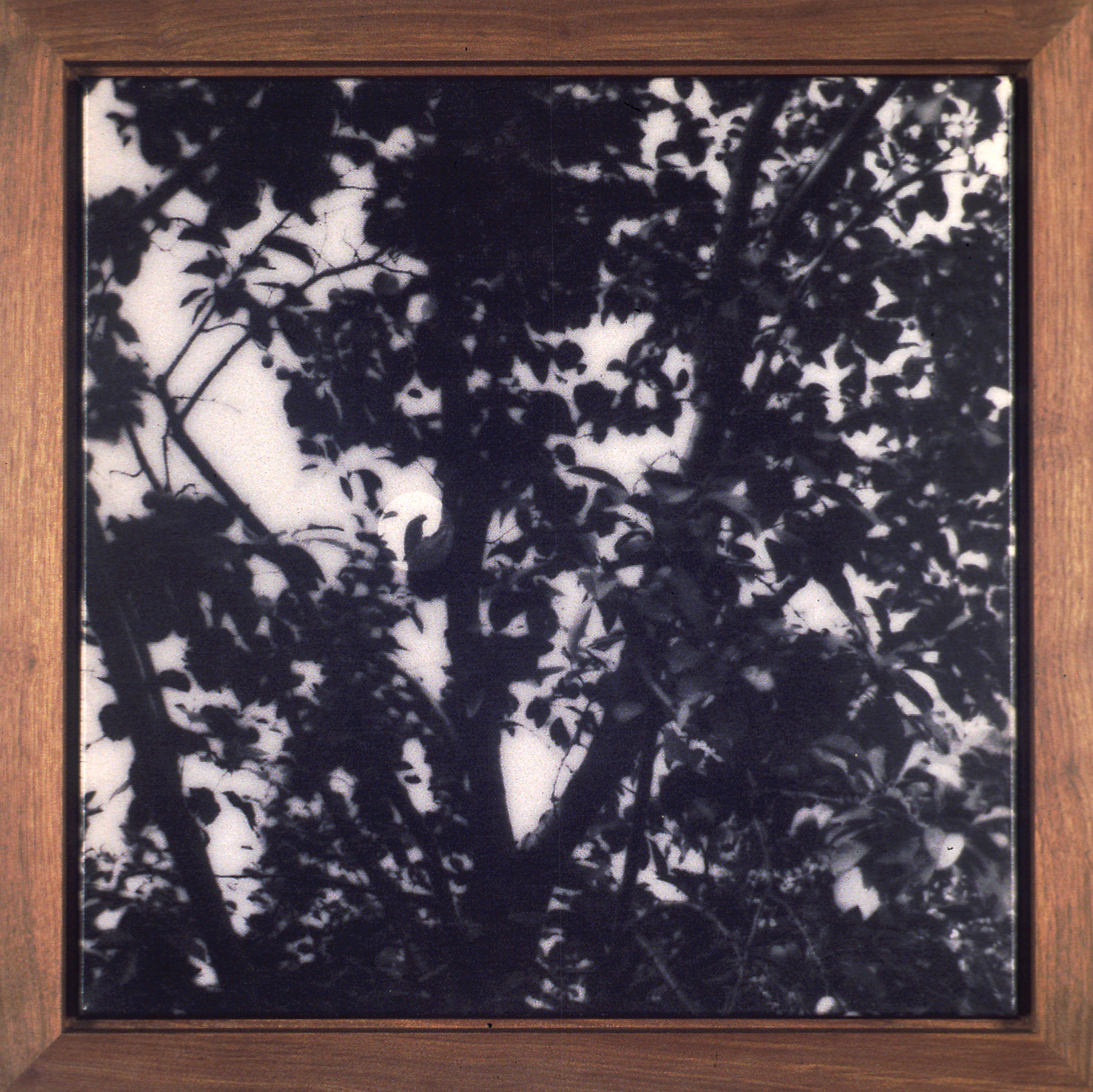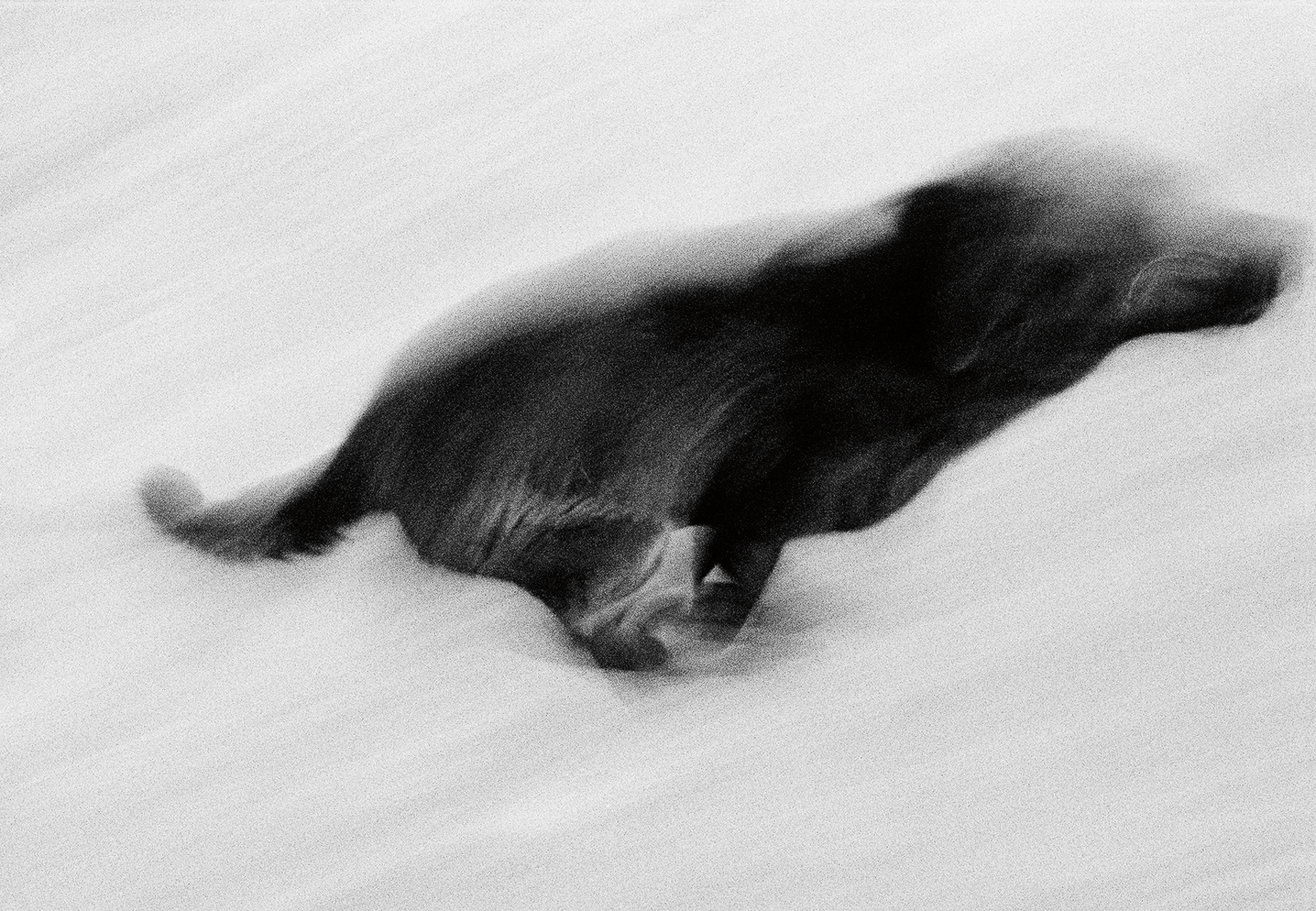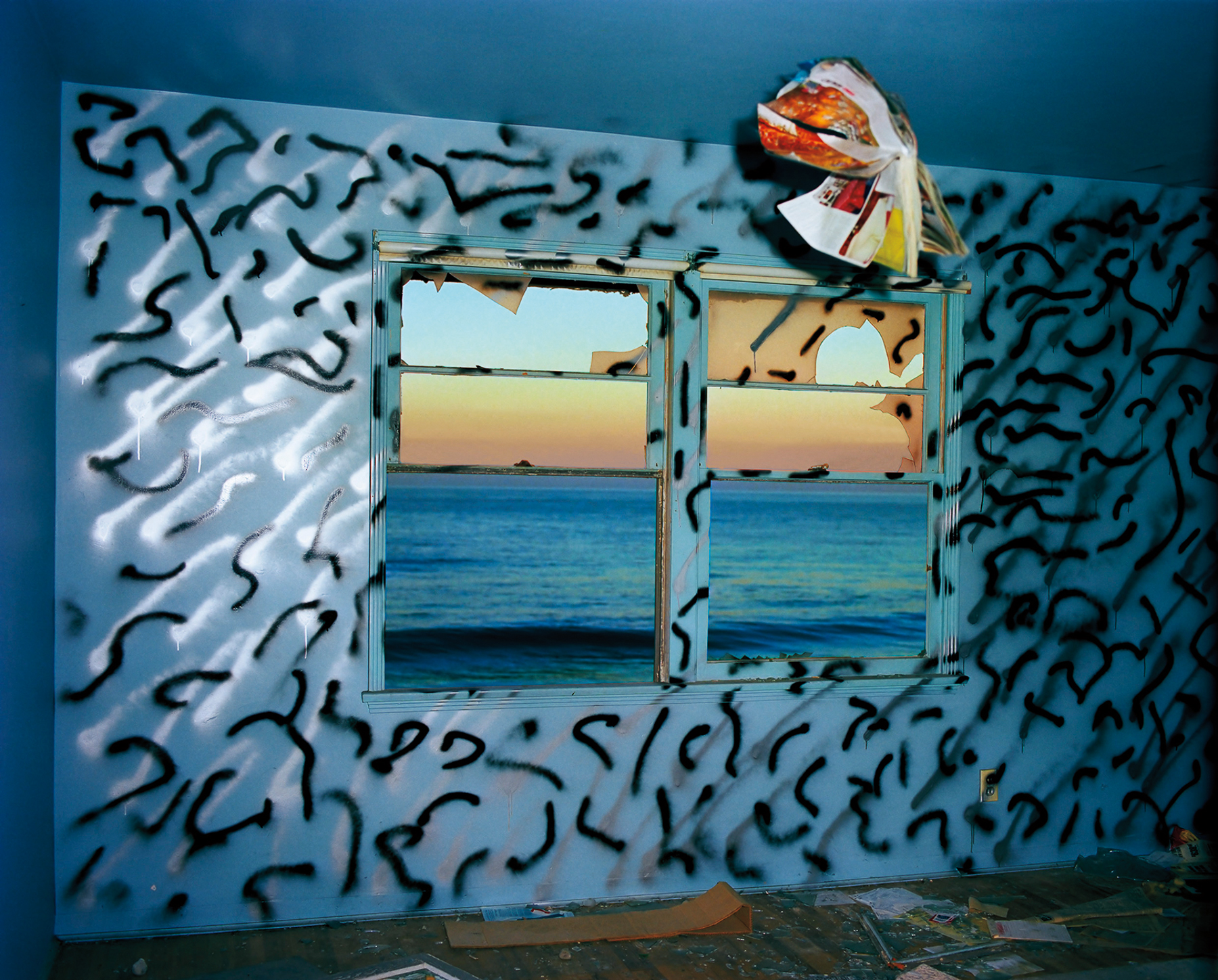John Divola’s career is defined by an inquiry into incident and photography’s astonishing yet inadequate aptitude in its precise description. An illustrative case can be found in the work for which his recent three-city Southern California survey was named, and whose long title contains within it one highly generative but seemingly insoluble contradiction. The title, As Far as I Could Get, 10 Seconds, 12_15_2010, 3:29 PM to 3:42 PM PST, 34.166301, -166.033714 (2010), corresponds to a large panoramic color photograph of a tight, apparently isolated cluster of tall desert trees, into or through which a man can be found to almost disappear as he flees the camera’s position. For this reprisal of a 1996 project (both versions were on view at Los Angeles County Museum of Art), Divola has set the self-timer of his digital camera to the once-conventional 10-second delay, triggered the shutter release, and bolted through the clearing in the small wood before him. It appears to be an elegant conceptual gesture: to make a photograph whose time is measured by its triggering subject’s traceable movement away from the camera in space. But the title’s attention to details and informational excess suggests that questions of photographic space and time might finally elude elegance. Just before concluding our reading with geo-coordinates situating the subject to about a meter’s accuracy just east of the intersection of Diamond Bar Road and North Star Avenue in Twentynine Palms, careful readers of this long title are confronted with the difficult premise that this giant photograph registering the ten-second mark in the photographer’s tree-ward dash sustained the full yawning stretch from 3:29 p.m. to 3:42 p.m.

John Divola, As Far as I Could Get, 10 Seconds, 12_15_2010, 3:29 PM to 3:42 PM PST, 34.166301, -166.033714, 2010. Pigment print; image and paper: 50 × 119 inches. Collection Dan and Jeanne Fauci. © John Divola.
Divola’s direction of our attention toward incommensurable particulars here is pronounced, exhorting us to see a picture that is noisily folding several competing temporalities into a single, impossibly sharp photographic field. Omitted from the title but readily knowable from the exhibition catalog is the fact that Divola made this picture by outfitting his camera with a Gigapan rig.1 Gigapan is a robotic mount, initially developed for NASA’s Mars Rover, that enables telephoto-equipped digital cameras to produce dynamic, astonishingly high-resolution “gigapixel” panoramic views by digitally stitching together into a single coherent picture hundreds of individual, perfectly calibrated, and information-rich exposures, each taken in a preprogrammed sequence tracing a grid. In the present case, the process absorbed thirteen minutes. What As Far As I Could Get, 10 Seconds therefore presents is not a snapshot in any traditional sense, such as might trap an instant (or whatever duration such an instant might contain) as in amber, but rather many dozens or more of these instants accumulated over nearly a quarter of an hour, with one instant in particular bracketed to mark the photographer’s own manual intervention in media res into and documented retreat from the otherwise automated proceedings.2 Insofar as the film theorist André Bazin might argue that “photography is a feeble technique in the sense that its instantaneity compels it to capture time only piecemeal,”3 Divola’s gesture is in important ways cinematic: a photographic registration of passing time, and an edited one to boot (if only “in camera”). But As Far as I Could Get, 10 Seconds is in the end every bit a photograph, containing within it the kind of trapped incident—Divola’s own frozen dash from his space-age Gigapan rig—that only the instantaneous snapshot seems equipped to record. (As early panoramic photography, with its multiple, panning exposures printed adjacently on a single sheet of paper, makes plain, a single contiguous photographic field has always potentially contained many distinct instants within it. But where and to what extent has that very anachronism been the photographer’s sitting subject?) Real pressure then is being applied to the limits of just what kind of time this medium is prepared to engage. That this pressure issues in part from the sharp marshaling of new novelties in the medium’s ever-expanding toolbox does nothing to disqualify the picture from membership in the club of things photographic. What it does do is expand the parameters of photographic possibility. Divola effectively disturbs an inherited and prescriptive set of laws such as we might associate with its more esteemed ontologists in order to take into account all at once a flash, ten seconds, fifteen minutes, even fourteen years—and in the present case, the period of looking will be unusually well-matched to that of the exposure itself. “Projecting the diachronic onto the plane of the synchronic,” as Victor Burgin describes the hybrid logic of the panorama,4 Divola has, in a sense, scooped out a very precise instant of mid-afternoon time from a very particular Southern California place and opened it out for us so that we might turn it in hand and see just how much it, as an instant, might or might not enfold.
This major picture establishes the terms for the survey in every conceivable way. Its image covers the catalog, and it was the first photograph I encountered at LACMA, preceding the small gallery where what was almost certainly the most visited (and also the most compelling) leg of the survey was installed. In ways that the catalog essays do not, As Far as I Could Get, 10 Seconds allusively asserts something like a unified thesis: Divola is a photographer troubling with the difficult question of photographic time, not in order to resolve it but rather to make more visible its very unresolvability, its resistance to ontological definition and constraint. Indeed, virtually all of the work in the show bears this out, and as often as not, familiar work comes to be recast with fresh insight by the light of the mural’s opening gambit.

John Divola, Artificial Nature [Catalogue p.66], 2002. Found gelatin silver print, 1959; 8 × 10 inches. Los Angeles County Museum of Art, purchased with funds provided by the Ralph M. Parsons Fund and the Photographic Arts Council. © John Divola.

John Divola, WX6276, 1995. Gelatin silver on linen with custom walnut frame; image: 20 × 20 inches. Courtesy of the artist. © John Divola.
A third body of work in the LACMA exhibition, Seven Songbirds and a Rabbit (1995), reveals Divola’s pursuit of incident in its intractable temporal anchorage at its most compelling. For this series, Divola shifted his archival attention from Warner Brothers to the Keystone-Mast stereographic negative archive now housed at the University of California, Riverside, where he teaches. That archive, which promises “an encyclopedic view of world history and cultural diversity,” consists of some 350,000 stereoscopic prints and negatives accumulated by the Keystone West View Company between 1892 and 1963.7 The Keystone collection would seem to offer through the stereograph’s illusion of perceptual depth some grasp on the encyclopedic whole in a perfect synthesis of spatial, thematic, and temporal plenitude. From within this dizzyingly comprehensive and taxonomized photographic field, Divola’s own more partial and idiosyncratic inventory yielded the birds and hare that lend the series its name. Where he found them among the Keystone negatives, he photographed them, isolating his chosen detail and introducing a round didactic highlight within that newly circumscribed field to further focus his viewer’s attention. Even with such a generous optical aid, the game is not always so quickly discovered. What most animates these pictures is their inferred exploitation of the virtually three-dimensional stereoscopic field as an emphatically spatial one where, as Oliver Wendell Holmes famously had it, “the scraggy branches of a tree in the foreground run out at us as if they would scratch our eyes out” and whose depths one must therefore navigate slowly in the discernment of such incident as Divola’s fleet woodland creatures embody.8 The pictures comprising Seven Songbirds and a Rabbit were printed on linen and framed in walnut, in order to call up the aesthetic of the nineteenth-century archive.9 But to my mind, the fascination triggered by this series is squarely attributable to its evocation of a careful and slow hunt through the stereograph’s virtual, ostensibly all-encompassing deep space, a hunt whose final quarry is the rather less ambitious singular, circumscribed incident trapped now in a flat photographic picture.

John Divola, D26F13, 1996–98. Inkjet print; image: 40 × 50 inches, paper: 44 × 54 inches. Courtesy of the artist. © John Divola.
It is difficult to look at Divola’s series Dogs Chasing My Car in the Desert (1996–98), included in the show’s Santa Barbara chapter, without some consideration of Eadweard Muybridge’s nineteenth-century contribution to our reckoning with photography and time. Divola’s pictures, taken almost carelessly from out his car’s window, register the blurred pursuit of the desert dogs whose otherwise perfect peace his engine has disturbed. In discussing this series, Divola speaks of his own investment in movement and photography’s unique gift for capturing “the imprint of circumstance,” surely themes residing well within Muybridge’s special wheelhouse.10 But in interviews, Divola denies that this series was informed by that earlier California photographer’s work, and I do believe that this makes an important kind of sense.11 Muybridge’s motion studies, despite all his bad-science shenanigans, were expressly motivated by a sense of photography’s capacity to make the world more knowable by making what could not before be seen newly visible. Divola’s program, while equally animated by photography’s temporal potential, is driven more by the pleasures afforded by photographing at the horizon of that potential’s very real and acknowledged epistemological limits. “The dog,” Divola has said of these pictures, “will never catch a car, and a camera will never capture reality.”12

John Divola, Zuma #70, 1977. Pigment print on rag paper; image: 21 × 26 inches, paper: 24 x 30 inches. Courtesy the artist. © John Divola.
At the Pomona College Museum of Art, Divola’s temporal conundrums were set into vivid color with a dedicated installation of the Zuma series. Made over two years in the late 1970s, the pictures document an abandoned and quite thoroughly wrecked Malibu beach house that had become a testing ground for vandals, drifters, and firefighters. The Zuma series revels in the house’s chronicled collapse into ruin. The structures people devise, houses for instance, are shown to thrust a desperate kind of order onto things that are otherwise incomprehensibly slow and big. Here the sun and tide and shades of night and day are perversely apportioned by the window’s frame. To whatever extent the Zuma pictures are a record of these incrementally slower and bigger things (a house, the ocean, the cosmos), they are also a record of Divola’s own relatively quick and modest activity of spray-painted defacement, whose duration can be contained by the far tighter schedule of the term of the house’s abandonment, if not a single visit. But it is finally that wretched tossed magazine (or is it some other catalog of the season’s passing fashions?), trapped in flight by a burst flashbulb, that rescues the picture from the weight of Romantic allegory and confirms its better status as a “mere” snapshot, a camera’s impression of a moment in time. Zuma #70, like As Far as I Could Get, 10 Seconds, is a hugely ambitious picture that is less about the big fish spatiotemporal reach of man’s reason than about acknowledging the limits of photography’s own marvelous but essentially measured corner of competence.
Jason E. Hill is a 2014–15 Andrew W. Mellon Foundation Fellow at the New York Historical Society.
